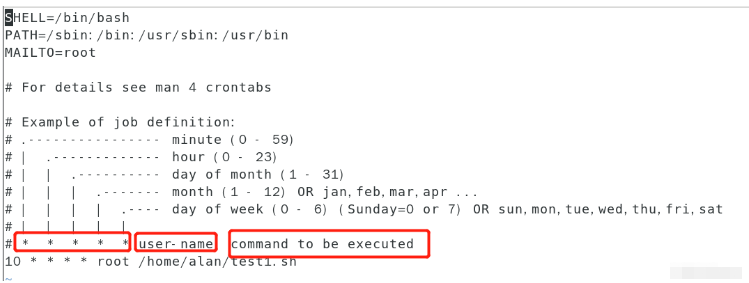
No nonsense, go directly to what you want:

such as As shown in the box, this command means that the script file in this directory will be executed every ten minutes, that is, /home/alan/test1.sh
Ok. Now let’s talk about why the command is like this. Write.
First of allcrond is a service used in the Linux system to regularly execute commands ##. After writing the command, the system will start the crondtask scheduling command. crond will regularly check whether there is work to be performed every minute. If the work is to be performed, it will automatically Do the job. crondService is like an alarm clock.
andcrontab is used to set the command to be executed periodically. This command reads the command from the standard input device and stores it in the "crontab" file in for subsequent reading and execution.
To put it bluntly, thecrond service needs to be implemented through crontab.
crontab command format
| Description | |
|---|---|
| is used to set a scheduled task for a certain user. | |
| file is the name of the command file. Indicates that the file is used as the task list file of crontab and loaded into crontab | |
| Edit the scheduled task of a certain user. If the user is not specified, it means the current user | |
| Display the scheduled tasks of a certain user. If no user is specified, it indicates the current user | |
| Delete a user's scheduled task. If no user is specified, it means that the current user | |
| is given when deleting a user's scheduled task. Confirmation prompt |
yum list installed | grep "crond"
: Check the crond service status.
: Start the crond service.
: Close the crond service.
: Restart the crond service.
: Reload the crond service.
3. How to use crontab
##Except for the # comment character, there are five in total from left to right Each * sign represents the minute, hour, day, month, and day of the week respectively. 
absolute path
directory, for example, mine is/home/alan/test1.sh)The specific meaning and range of the asterisks (from left to right):
| Time range | ||
|---|---|---|
| 0-59 | * | |
| 0-23 | * | |
| 1-31 | * | |
| 1-12 | ##* | The week of the week Day (week) |
| Besides *, there are other symbols with special meanings. |
Symbol
| * (asterisk) | ||
|---|---|---|
| , (comma) | Separate by commas to indicate the value of this field | |
| -(middle pole) | represents the value range between two integers | |
| / (forward slash) | Indicates how often the execution interval is | |
The above is the detailed content of How to write a crontab scheduled execution script in Linux. For more information, please follow other related articles on the PHP Chinese website!




